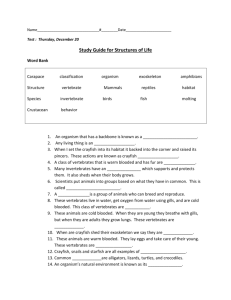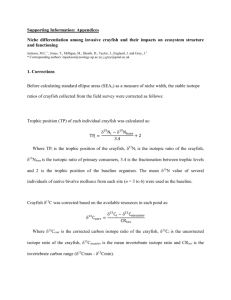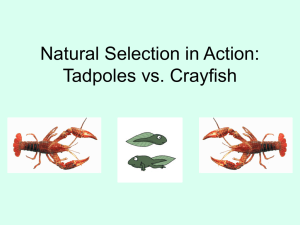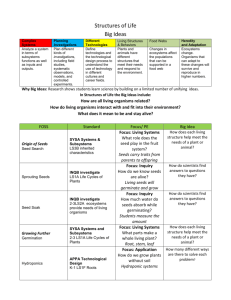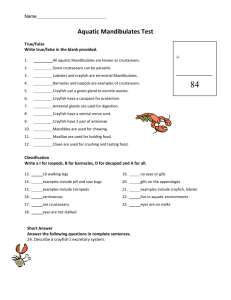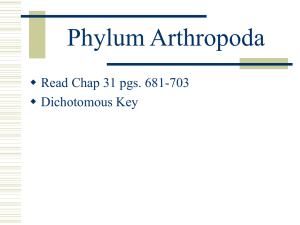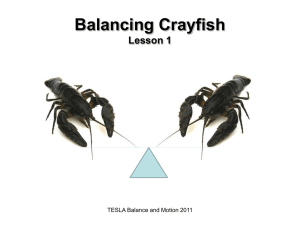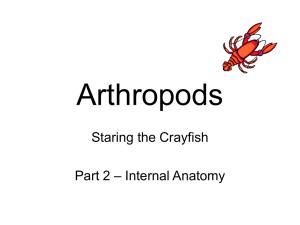Heart Measures In Crayfish During Environmental Changes
advertisement
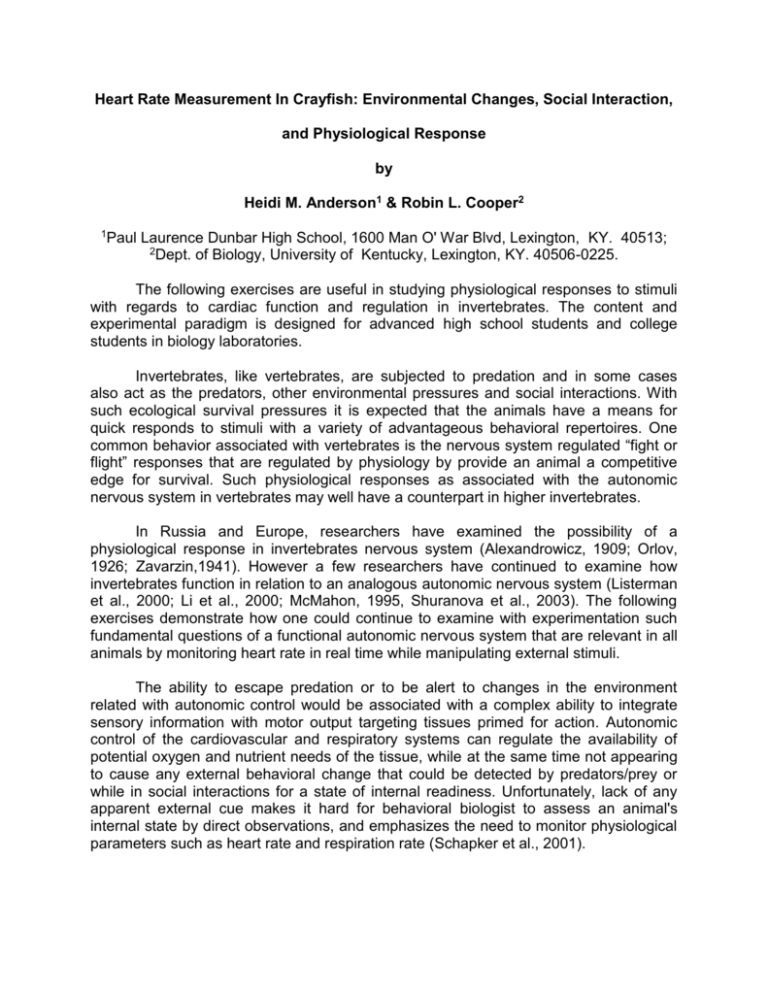
Heart Rate Measurement In Crayfish: Environmental Changes, Social Interaction, and Physiological Response by Heidi M. Anderson1 & Robin L. Cooper2 1Paul Laurence Dunbar High School, 1600 Man O' War Blvd, Lexington, KY. 40513; 2Dept. of Biology, University of Kentucky, Lexington, KY. 40506-0225. The following exercises are useful in studying physiological responses to stimuli with regards to cardiac function and regulation in invertebrates. The content and experimental paradigm is designed for advanced high school students and college students in biology laboratories. Invertebrates, like vertebrates, are subjected to predation and in some cases also act as the predators, other environmental pressures and social interactions. With such ecological survival pressures it is expected that the animals have a means for quick responds to stimuli with a variety of advantageous behavioral repertoires. One common behavior associated with vertebrates is the nervous system regulated “fight or flight” responses that are regulated by physiology by provide an animal a competitive edge for survival. Such physiological responses as associated with the autonomic nervous system in vertebrates may well have a counterpart in higher invertebrates. In Russia and Europe, researchers have examined the possibility of a physiological response in invertebrates nervous system (Alexandrowicz, 1909; Orlov, 1926; Zavarzin,1941). However a few researchers have continued to examine how invertebrates function in relation to an analogous autonomic nervous system (Listerman et al., 2000; Li et al., 2000; McMahon, 1995, Shuranova et al., 2003). The following exercises demonstrate how one could continue to examine with experimentation such fundamental questions of a functional autonomic nervous system that are relevant in all animals by monitoring heart rate in real time while manipulating external stimuli. The ability to escape predation or to be alert to changes in the environment related with autonomic control would be associated with a complex ability to integrate sensory information with motor output targeting tissues primed for action. Autonomic control of the cardiovascular and respiratory systems can regulate the availability of potential oxygen and nutrient needs of the tissue, while at the same time not appearing to cause any external behavioral change that could be detected by predators/prey or while in social interactions for a state of internal readiness. Unfortunately, lack of any apparent external cue makes it hard for behavioral biologist to assess an animal's internal state by direct observations, and emphasizes the need to monitor physiological parameters such as heart rate and respiration rate (Schapker et al., 2001). In these experiments, we utilize the crayfish as the model animal since it is relatively easy to obtain and can be used for other learning modules in the class room over the year. In addition, a number of Middle and High schools use the crayfish for anatomical dissection so students are familiar with the anatomy. In relation to animal behavior the crayfish also serves as a good model for examining social interactions because a social hierarchy exists with crayfish (Listerman et al., 2000). There are many practical experimental arrangements that can be readily implemented in a laboratory classroom to examine the responsiveness of crayfish with using the heart rate as a bioindex. The goals in this experiment are: (1) To highlight various types of experiments that students could design on their own for experimental inquiry. (AP Biology- “Science as a Process”, NSES- “Science Inquiry”) (2) To convey an understanding in the regulation of heart rate and highlight similarities and differences between vertebrates and invertebrates. (AP Biology- “Unity in Diversity”). (3) To allow students to ask further questions based on experiences with invertebrate models and to develop experimental designs for further research. (AP Biology-“Science as a Process”). (4) To give students further experience with technological advancements and collection and manipulation of data using Vernier probes. (AP Biology-“Science, Technology, and Society”). The supplies consist of the following items: 1. Crayfish (obtained from various biological suppliers or fish farms) 2. Vernier LabPro (Vernier Software & Technology, 13979 SW Millikan Way, Beaverton, OR, 97005-2886, USA) 3. The human ECG module sold separately or together with the LabPro (same company that sells the LabPro) 4. Two meters of coated stainless steel wire (diameter 0.005 inches and with the coating 0.008 inches; A-M systems, Inc., Carlsburg, WA). 5. A TI-83PLUS or TI-86 with the LabPro software installed. USB port required for data transfer from LabPro to computer or can go directly to computer. 6. Dissecting scalpel blade 7. Super Glue (cyanoacrylate ester and accelerator can be obtained at most craft stores such as HobbyTown USA) Methods The same procedures are described in an earlier study for obtaining heart rates (Listerman et al., 2000) with the exception of insulated stainless steel wires(diameter 0.005 inches and with the coating 0.008 inches; A-M systems, Inc., Carlsburg, WA). The tips of the wires to be placed in the animal are stripped of the insulation by using a fire from a match. Only about 1/8 of an inch is required to be stripped. These ends are bent 90 degrees to aid in holding them in the animal while glue them in place (Figure 1). The crayfish is wrapped in moist towels with its chelipeds wrapped well and forced against its body underside. The tail is tucked under the animal and wrapped with a paper towel to keep the animal from tail flipping while placing the recording leads into the animal. The tips are to be placed under the dorsal carapace directly over the heart to record the heart rate. These two wires were placed to span the heart in a rostral-caudal arrangement to insure an accurate measure during each contraction. A third wire is placed under the cuticle in the rostral area of the thoracic chamber to serve as a ground. Wires were inserted through holes drilled in the carapace and cemented in place with cyanoacrylate ester and accelerator (HobbyTown USA, Lexington, KY). The use of this rapid drying glue reduced handling stress of the animals which is known to have an effect on heart rate (Wilkens et al.,1985; Listerman et al., 2000). To make the smallest hole possible for less loose of blood (hemolymph) a sharp pointed scalpel blade (a #11 blade) is used. The scalpel is turned around and around slowly on the location where the holes are desired. Just as one is about through the carapace poke a small needle through the depression made by the scalpel blade until a little bit of hemolymph appears. Another person will then need to place the bent lead into the hole and with a slight pull to one side to keep the wire taut. Before placing the super glue over the hole with the wire in it dab of any remaining hemolymph. Repeat same procedure for the other two wires. (Figure 2A, B). **Caution- Do NOT make the holes over the gill chambers since that fluid in the gill chamber is the same as the external aquaria water. Do not push the wires too deep into the animal as the ends will hit through the heart and other vital organs. If too much super glue gets into the holes, which are in the thoracic cavity, the crayfish will die so use only a small amount. If the holes were made too big then modeling clay can be used to seal the hole and reduce the bleeding until the wires are placed in the holes and glued in place. Secure the other end of the wire to a the alligator clips placing for the red and green leads which should span the heart and the black lead attach to the wire placed in the anterior part of the thoracic above the heart (Figure 2B). Turn on the calculator or start the software on a computer for the LabPro. Change the setting to acquire 200 points/sec and to acquire for 60 seconds of data. The data should look close to that shown in Figure 3. The waveforms will vary depending on the location of the leads to the heart. The point here is that the beats per minute can be determined from the recordings. Experimental manipulations 1. After the animals are used to their holding tanks. Observe what happens as the water in the tank is drained. Then refill the tank gradually with water. Q: What kind of responses occurred with heart rate in the two experimental manipulations? Q: What other environmental changes would these animals experience in nature and what responses can we model in the lab setting to measure physiological responses? Various environmental disturbances can be tested: bright light, a shadow over head, or even a tap on the side of the tank. These disturbances should be discussed in relation to what type of predators exists in the animals natural environment. Q: How does heart rate change under stress conditions? 2. The length of time a crayfish is exposed to air, by having the water in the tank drained, can be related to oxygen debt and pay back after the water in the tank is added back. Q: How fast do crayfish rebound from oxygen debts? Q: What connect is there to heart rate and respiration rate after oxygen debt? 3. Place cleaned ice packs within the water the crayfish is housed. Q: What happens to heart rate with decreasing temperature? Q: What happens as the water temperature is increased? 4. Crayfish and exercise. The crayfish can be induced to exercise while being moved in the tank by a rolling object like a PVC pipe that slowly rolls down a slope of a slanted tank (with or without water). This can be compared with human HR and exercise or fear. Q: How do crayfish heart rates recover from exercise? Q: Do crayfish heart rates change after repeated exercise? 5. Social interactions. Place two male crayfish (they can be the same size or even different sizes) in the same tank together. Have one group of students score the crayfish based on behavioral posturing (aggressive or submissive or unresponsive behaviors) while the other group monitors heart rate during a common observation period. Some behaviors will be marked as a dominate posture by one crayfish and an unresponsive behavior in the other however the HR measures will reveal a difference if the animals are in visual distance of each other. If a behavioral unresponsive crayfish sees the opponent raise its chelipeds, the heart rate will increase but behavioral observations may not detect any significant change in the animal observing the postural displays of the opponent. Q: How do social interactions differ in external response and physiological response? Q: Which social interactions lead to the greatest increase of heart rate? Q: Which visible aggressive interactions lead to various physiological responses? References Alexandrowicz, J.S., 1909 Zur Kenntnis des sympathischen Nervensystems der Crustaceen. Jenaische Zeitschrift fuer Naturwissenschaften, 45, 395-444. Breithaupt, T. & Eger, P. 2002 Urine makes the difference: chemical communication in fighting crayfish made visible. J. Exp. Biol. 205, 1221-1231. Li, H., Listerman, R., Doshi, D., Cooper, R.L., 2000. Heart rate measures in blind cave crayfish during environmental disturbances and social interactions. Comparative Biochemistry and Physiology, 127A, 55-70. Listerman, R., Deskins, J., Bradacs, H., Cooper, R.L., 2000. Measures of heart rate during social interactions in crayfish and effects of 5-HT. Comparative Biochemistry and Physiology 125A, 251-263. McMahon, B.R., 1995. Integrated neural and neurohormonal control of respiratory and circulatory function in crustaceans: Is there evidence for an >autonomic= control system? Verh. Dtsch. Zool. Ges., 88.2, 87-101. Orlov, Ju., 1926. Die Innervation des Darmes des Flusskrebses. Zeitschrift fuer mikroskopisch-anatomische Forschung, 4: 101-148. Schapker, H., Breithaupt, T., Shuranova, Z., Burmistrov, Y., Cooper, R.L., 2002. Heart and ventilatory measures in crayfish during environmental disturbances and social interactions. Comp. Biochem. Physiol., 131A, 397-407. Shuranova, Z.P., Burmistrov, Y.M., and Cooper, R.L. (2003). A hundred years ago and now: A short essay on the study of the crustacean hindgut. (Vor hundert Jahren und nun: Eine kurze Geschichte von die Forschung des Hinterdarmes der Crustaceen). Crustaceana, 76, 755-760. Wilkens, J.L., Mercier, A.J., Evans, J., 1985. Cardiac and ventilatory responses to stress and to neurohormonal modulators by the shore crab Carcinus maenas. Comp. Biochem. Physiol. C, 82, 337-343. Zavarzin AA (1941) Ocherki po evol'utsionnoj gistologii nervnoj sistemy (Essays on the evolutionary histology of the nervous system) [in Russian]. In A.A.Zavarzin, Izbrannye trudy (Selected Works), Tom III, Izdatel'stvo AN SSSR: MoskvaLeningrad, 1950 Acknowledgments Funding was provided by NSF-IBN-0131459, Research Experience for Teachers (RET) supplement. Figure 1: Wire with insulation for use with ECG. Figure 2A: Intact crayfish wired for recordings Figure 2B: A schematic in the placement of the wires Figure 3: 10 seconds, 30 seconds and 1 minute time scales shown.

